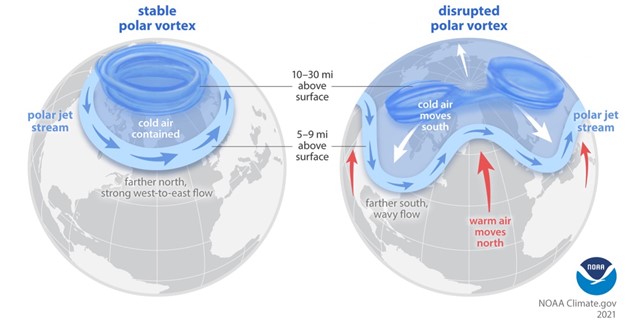Toon has a Master’s Degree in Civil Engineering (major in Energy) from the KU Leuven. He completed a 6 month internship as Derivates Analist. He work as a Junior Climate Consultant for Econopolis Climate and works on advisory projects related to climate & energy. Toon is also founder of Stroomloop, a unique trailrunning experience.
What Happens in the Arctic, Doesn't Stay in the Arctic: Understanding the Polar Vortex and Climate Change
This week, Belgium witnessed a picturesque winter scene with its first snowfall. As temperatures are likely to rise in the following weeks, it marks a beautiful end of a two-week cold snap. This cold snap had its roots in the fascinating and complex dynamics of the polar vortex.
To grasp this concept, let's delve into some essential meteorological concepts. During the northern hemisphere's winter, a cold, dry wind circulates at high altitudes. This is primarily a result of the significant temperature difference between the frigid North Pole, which receives minimal solar energy, and the much warmer equatorial regions.
Typically, this so-called polar vortex is kept in check by a robust jet stream that encircles the globe. However, the stability of this system can be disrupted. Warm air interacting with the jet stream can lead to disturbances in the polar vortex, causing it to bulge southward. This results in significantly colder weather in Europe and North America during winter. Usually, Europe experiences this effect first, followed by North America. These disturbances are normal, occurring a couple of times each winter period. Belgium's recent snowfall, occurring after a week of near-freezing temperatures, is most likely a manifestation of such a disruption.

Figure 1: The polar vortex. Source: NOAA
In the context of global climate change, this phenomenon garners even more interest. Scientists are actively studying how rising global temperatures and climate change impact the (disruptions of the) polar vortex. A theory gaining attention is that increased Arctic temperatures might lead to more frequent and intense disruptions of the polar vortex, pushing colder weather further south than usual. This could explain the recent rather extreme cold spell in Sweden and Finland from the past week. While there's no unanimous consensus yet on the exact effects, the influence of climate change on these atmospheric patterns is undeniable.
The possible impact of global warming on the polar vortex highlights the complexity of climate change. Climate change does not simply implicate a mere increase in global temperatures. It also pertains to the alteration of various climatological events and atmospheric conditions. The dynamics of the polar vortex and the consequent weather patterns are prime examples of these changes.
So, what does this mean for our winters? Will we still experience cold days in a significantly warmer world? Most likely, yes. However, these cold spells might not resemble what we are used to. Much like the increasingly intense heatwaves in summer, winter weather might take on a new character, shaped by the evolving climate and atmospheric dynamics.
In conclusion, as we witnessed Belgium's first snow of the season, it's an opportunity not just to revel in its beauty, but also a reminder that “what happens in the Arctic doesn't necessarily stay in the Arctic”. As we continue to observe and study these phenomena, it becomes increasingly clear that our understanding and responses to climate change must be as dynamic and multifaceted as the climate system itself.
